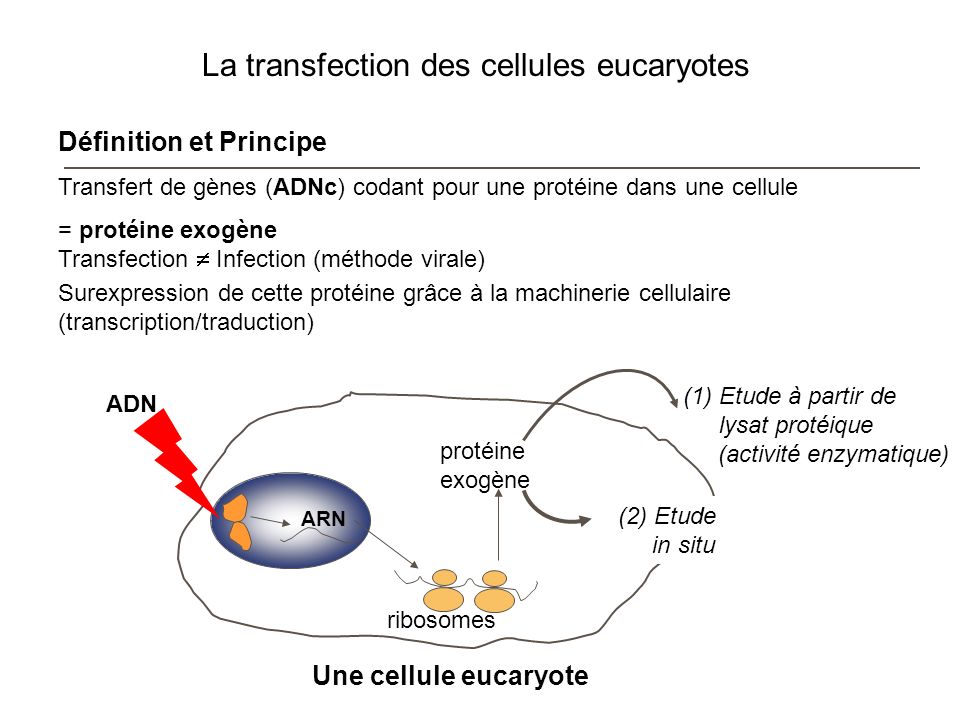Transfection is an essential technique in molecular biology, but it has both advantages and disadvantages. It enables genetic material to be introduced into cells, opening up a wide range of research possibilities. However, it can also be cytotoxic, leading to non-specific results. It is therefore important to carefully weigh up the advantages and disadvantages of this method before using it in a study.
Gene Silencing Methods: CRISPR vs. TALENs vs. RNAi
[arve url="https://www.youtube.com/embed/U3Z4u0DKbx0″/]
What are the differences between transient and stable transfection?
Transfection is a technique commonly used in biology to introduce genetic material into cells. It can be carried out either transiently or stably.
Transient transfection refers to the temporary introduction of exogenous DNA or RNA into cells. This process enables the expression of the introduced genetic material for a limited period, generally from a few days to a few weeks. Cells are generally transfected using viral vectors or liposomes. Transient transfection is often used to study the function of a particular gene or to produce recombinant proteins in the short term. However, it does not guarantee lasting expression of the genetic material.
Stable transfectionon the other hand, involves the permanent introduction of exogenous DNA into cells. The genetic material is often integrated into the cell genome, enabling constant, long-lasting expression. Stably transfected cells are selected using appropriate selection agents, such as antibiotics, to promote the survival of cells that have integrated the exogenous DNA. Stable transfection is often used to generate cell lines that continuously express a specific protein or interfering RNA.
In short, the transient transfection is a short-term method that allows temporary expression of genetic material, while the stable transfection is permanent and allows sustained expression of genetic material. Both techniques are useful in different research contexts and have their own advantages and disadvantages.
How does Lipofectamine work?
Lipofectamine is a reagent used in molecular biology to introduce nucleic acids into cells. It works by forming lipid complexes with DNA or RNA, facilitating their entry into cells.
Lipofectamine uses a transfection approach based on the formation of cationic liposomes. These liposomes are made up of positively charged phospholipids, enabling them to interact with negatively charged nucleic acids. When Lipofectamine is mixed with DNA or RNA, the liposomes encapsulate the nucleic acid molecules and form lipid complexes.
These lipid complexes can then be added to cells in culture. Liposomes fuse with the cell's plasma membrane, releasing the nucleic acids inside. Once inside the cell, nucleic acids can be used to express specific proteins or affect cell function.
The use of Lipofectamine offers several advantages. It enables efficient transfection in different cell types, including primary and suspension cells. What's more, it's relatively simple to use and requires no specialized equipment.
HoweverHowever, it should be noted that Lipofectamine can sometimes cause cytotoxicity and local inflammation, which can have undesirable effects on cells. It is therefore important to optimize transfection conditions to minimize these effects.
In conclusion, Lipofectamine is a reagent widely used in molecular biology to introduce nucleic acids into cells. It can be used to study and manipulate cell function for research purposes and the development of new genetic therapies.
How do you make a stable transfection?
Stable transfection is a process used in molecular biology to introduce and permanently express a foreign gene in cells. Here are the main steps involved in stable transfection:
1. Choice of transfection vector : The transfection vector is an essential element for stable transfection. It must contain a reporter gene, such as a gene encoding a fluorescent protein, to enable selection of transfected cells.
2. Preparation of the transfection complex : To transfer the vector into cells, it is necessary to prepare a transfection complex. This complex is generally formed by associating the vector with a transfection agent, such as polyethyleneimine (PEI), which facilitates entry of the vector into the cells.
3. Transfection of cells : The cells are then exposed to the transfection complex, usually by incubation for a few hours. It is important to take into account the specific conditions of each cell type, as these can vary in terms of sensitivity to transfection and tolerance to transfection agents.
4. Selection of transfected cells : After transfection, the cells undergo selection to eliminate those that have not integrated the transfection vector. This selection can be carried out using a selection agent, such as an antibiotic or drug, which allows only cells containing the reporter gene to survive.
5. Amplification and characterization of selected cells : Selected transfected cells are then amplified to obtain a more homogeneous population. This may require several cell passages. Finally, transfected cells can be characterized by various techniques, such as PCR or immunofluorescence, to verify integration and expression of the foreign gene.
Stable transfection is a complex process requiring careful planning and a good knowledge of the basic principles of molecular biology. It is advisable to consult the specialized scientific literature or call on experts in the field for more detailed information on the specific steps involved in stable transfection.
In conclusion, transfection has both advantages and disadvantages. On the one hand, transfection makes it possible to specifically introduce genes or molecules into cells, opening up new perspectives in biological and medical research. Scientists can study genetic mechanisms, develop new treatments or improve existing therapies. In addition, transfection offers a fast and efficient way of producing recombinant proteins for research or production purposes.
On the other hand, transfection can also have its drawbacks. Firstly, the technique can be complex and often requires advanced technical expertise to achieve reliable results. In addition, transfection can lead to undesirable effects such as cell damage, immune response or even cell transformation. It is therefore essential to master the protocols and take all necessary precautions when using this technique.
Despite its limitations, transfection remains a valuable and widely used method in biomedical research. By combining complementary approaches and continuing to develop new techniques, scientists can fully exploit the potential of transfection for new discoveries and advances in molecular biology and medicine.








